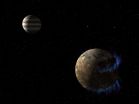(Press-News.org) NASA's Hubble Space Telescope has the best evidence yet for an underground saltwater ocean on Ganymede, Jupiter's largest moon. The subterranean ocean is thought to have more water than all the water on Earth's surface.
Identifying liquid water is crucial in the search for habitable worlds beyond Earth and for the search of life as we know it.
"This discovery marks a significant milestone, highlighting what only Hubble can accomplish," said John Grunsfeld, associate administrator of NASA's Science Mission Directorate at NASA Headquarters, Washington. "In its 25 years in orbit, Hubble has made many scientific discoveries in our own solar system. A deep ocean under the icy crust of Ganymede opens up further exciting possibilities for life beyond Earth."
Ganymede is the largest moon in our solar system and the only moon with its own magnetic field. The magnetic field causes aurorae, which are ribbons of glowing, hot electrified gas, in regions circling the north and south poles of the moon. Because Ganymede is close to Jupiter, it is also embedded in Jupiter's magnetic field. When Jupiter's magnetic field changes, the aurorae on Ganymede also change, "rocking" back and forth.
By watching the rocking motion of the two aurorae, scientists were able to determine that a large amount of saltwater exists beneath Ganymede's crust affecting its magnetic field.
A team of scientists led by Joachim Saur of the University of Cologne in Germany came up with the idea of using Hubble to learn more about the inside of the moon.
"I was always brainstorming how we could use a telescope in other ways," said Saur. "Is there a way you could use a telescope to look inside a planetary body? Then I thought, the aurorae! Because aurorae are controlled by the magnetic field, if you observe the aurorae in an appropriate way, you learn something about the magnetic field. If you know the magnetic field, then you know something about the moon's interior."
If a saltwater ocean were present, Jupiter's magnetic field would create a secondary magnetic field in the ocean that would counter Jupiter's field. This "magnetic friction" would suppress the rocking of the aurorae. This ocean fights Jupiter's magnetic field so strongly that it reduces the rocking of the aurorae to 2 degrees, instead of the 6 degrees, if the ocean was not present.
Scientists estimate the ocean is 60 miles (100 kilometers) thick - 10 times deeper than Earth's oceans - and is buried under a 95-mile (150-kilometer) crust of mostly ice.
Scientists first suspected an ocean in Ganymede in the 1970s, based on models of the large moon. NASA's Galileo mission measured Ganymede's magnetic field in 2002, providing the first evidence supporting those suspicions. The Galileo spacecraft took brief "snapshot" measurements of the magnetic field in 20-minute intervals, but its observations were too brief to distinctly catch the cyclical rocking of the ocean's secondary magnetic field.
The new observations were done in ultraviolet light and could only be accomplished with a space telescope high above the Earth's atmosphere, which blocks most ultraviolet light.
INFORMATION:
NASA's Hubble Space Telescope is celebrating 25 years of groundbreaking science on April 24. It has transformed our understanding of our solar system and beyond, and helped us find our place among the stars. To join the conversation about 25 years of Hubble discoveries, use the hashtag #Hubble25.
Hubble is a project of international cooperation between NASA and ESA (European Space Agency). NASA's Goddard Space Flight Center in Greenbelt, Maryland, manages the telescope. The Space Telescope Science Institute (STScI) in Baltimore, Maryland, conducts Hubble science operations. STScI is operated for NASA by the Association of Universities for Research in Astronomy, Inc., in Washington.
For images and more information about Hubble, visit:
http://www.nasa.gov/hubble
and
http://hubblesite.org/news/2015/09
CHICAGO --- A father's depression during the first years of parenting - as well as a mother's - can put their toddler at risk of developing troubling behaviors such as hitting, lying, anxiety and sadness during a critical time of development, according to a new Northwestern Medicine study.
This is one of the first studies to show that the impact of a father's depression from postpartum to toddlerhood is the same as a mother's. Previous studies have focused mostly on mothers with postpartum depression and found that their symptoms may impact their children's behavior during ...
Unique proteins newly discovered in heat-loving bacteria are more than capable of attaching themselves to plant cellulose, possibly paving the way for more efficient methods of converting plant matter into biofuels.
The unusual proteins, called tapirins (derived from the Maori verb 'to join'), bind tightly to cellulose, a key structural component of plant cell walls, enabling these bacteria to break down cellulose. The conversion of cellulose to liquid biofuels, such as ethanol, is paramount to the use of renewable feedstocks.
In a paper published online in the Journal ...
WINSTON-SALEM, N.C. - March 12, 2015 - A recently developed risk-evaluation protocol can help hospital emergency department personnel more efficiently determine which patients with acute chest pain can be sent home safely, according to a randomized trial conducted at Wake Forest Baptist Medical Center.
The study, published in the current online issue of the American Heart Association journal Circulation: Cardiovascular Quality and Outcomes, found that chest-pain patients who were evaluated with the new protocol, called the HEART Pathway, had 12 percent fewer cardiac tests, ...
The Brazilian Navy Hydrographic Centre reported that a sub-tropical storm had formed on March 11 near east of the Brazilian state of Rio Grande do Sul, the southeastern most state in Brazil.
NOAA's GOES-East satellite provided imagery of the Atlantic that showed Subtropical Cyclone 90Q off the southeastern coast of Brazil at 17:45 UTC (1:45 p.m. EDT). The system appeared to have fragmented banding of thunderstorms around the low-level center. The image was created by NASA/NOAA's GOES Project at NASA's Goddard Space Flight Center in Greenbelt, Maryland.
At 1200 UTC (8 ...
For more than 100 years, marine biologists at Friday Harbor Laboratories have studied the ecology of everything from tiny marine plants to giant sea stars.
Now, as the oceans are undergoing a historic shift in chemistry, the lab is establishing itself as a place to study what that will mean for marine life. And the University of Washington laboratory is uniquely placed in naturally acidic waters that may be some of the first pushed over the edge by human-generated carbon emissions.
A paper published last month in Limnology and Oceanography tracks about two years of ...
Case Western Reserve scientists have discovered that speed matters when it comes to how messenger RNA (mRNA) deciphers critical information within the genetic code -- the complex chain of instructions critical to sustaining life. The investigators' findings, which appear in the March 12 journal Cell, give scientists critical new information in determining how best to engage cells to treat illness -- and, ultimately, keep them from emerging in the first place.
"Our discovery is that the genetic code is more complex than we knew," said senior researcher Jeff Coller, PhD, ...
CHAMPAIGN, Ill. -- A new molecule-making machine could do for chemistry what 3-D printing did for engineering: Make it fast, flexible and accessible to anyone.
Chemists at the University of Illinois, led by chemistry professor and medical doctor Martin D. Burke, built the machine to assemble complex small molecules at the click of a mouse, like a 3-D printer at the molecular level. The automated process has the potential to greatly speed up and enable new drug development and other technologies that rely on small molecules.
"We wanted to take a very complex process, ...
A new study finds that Interleukin-3 (IL-3), an inflammatory factor most associated with allergic reactions, appears to have an important role in the overwhelming, life-threatening immune reaction called sepsis. In the March 13 issue of Science, investigators from Massachusetts General Hospital (MGH) describe finding that the presence of IL-3 is essential to the development of sepsis in a mouse model of the condition and that IL-3 levels in human patients with sepsis are higher in those at greater risk of dying.
"Sepsis is an extremely dangerous conditions that claims ...
An international research team has shed new light on the diet of some of the earliest recorded humans in Sri Lanka. The researchers from Oxford University, working with a team from Sri Lanka and the University of Bradford, analysed the carbon and oxygen isotopes in the teeth of 26 individuals, with the oldest dating back 20,000 years. They found that nearly all the teeth analysed suggested a diet largely sourced from the rainforest.
This study, published in the early online edition of the journal, Science, shows that early modern humans adapted to living in the rainforest ...
An international study involving the University of Southampton suggests there could be a rise in measles cases of 100,000 across the three countries most affected by the Ebola outbreak in West Africa due to health system disruptions.
The research in the journal Science, led by Princeton and Johns Hopkins University in the USA, predicts that the size of a measles outbreak will increase from 127,000 at the start of the Ebola epidemic in early 2014, to 227,000 after 18 months of the outbreak. This would result in an additional 5,000 measles deaths, and potentially as many ...




